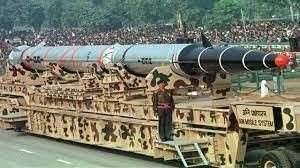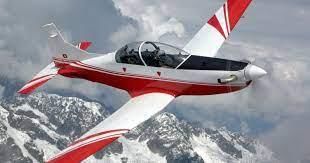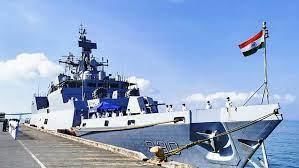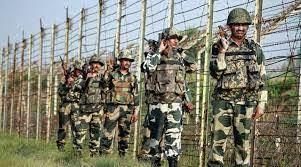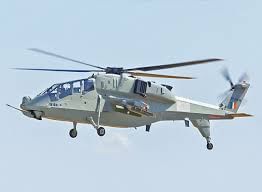Internal Security - 6 | Current Affairs & Hindu Analysis: Daily, Weekly & Monthly - UPSC PDF Download
| Table of contents |

|
| Successful Training Launch of Short-Range Ballistic Missile ‘Agni-1’ |

|
| Pilatus PC-7 Mk II |

|
| Indian Navy Day 2023 |

|
| Extending BSF Jurisdiction |

|
| Tejas Jets and Prachand Helicopters |

|
Successful Training Launch of Short-Range Ballistic Missile ‘Agni-1’
The Short-Range Ballistic Missile 'Agni-1' was successfully launched from APJ Abdul Kalam Island, Odisha, in a recent training exercise. The launch, conducted under the supervision of the Strategic Forces Command, effectively confirmed the validation of all operational and technical parameters.
About Agni-1 Ballistic Missile
- The Agni-1 is a Short-Range Ballistic Missile (SRBM) created by India as part of the Agni missile series. Serving as the inaugural missile in the Agni series, it functions as a strategic weapon with the capability to transport a nuclear payload.
- Primarily designed as a deterrent against potential adversaries, Agni-1 is renowned for its swift response time. This missile represents the initial variant in the Agni series developed under the Integrated Guided Missile Development Program (IGMDP).
Technical Features:
- Agni-1 is a single-stage, solid-fueled missile boasting a range spanning approximately 700 to 1200 kilometers and a payload capacity of 1,000 kg. Classified as a short-range ballistic missile, it can accommodate both conventional and nuclear warheads. The adoption of a solid-fuel propulsion system enhances operational flexibility while reducing launch preparation time.
Development and Testing:
- The Defence Research and Development Organisation (DRDO) in India spearheaded the development of Agni-1. The missile has undergone multiple successful test launches aimed at validating its performance and reliability. Agni-1's inaugural test took place at the Interim Test Range in Chandipur in 1989, and it was officially accepted into service by the Indian army in 2007.
What are the Other Agni Class of Missiles?
The Agni series is a family of ballistic missiles developed by India, with each variant designed for specific ranges and purposes. Besides Agni-1, other notable missiles in the series include:
Range of other Agni Missiles:
- Agni II: Range more than 2000 km.
- Agni III: Range of more than 2,500 Km
- Agni IV: Range is more than 3,500 km and can fire from a road-mobile launcher.
- Agni-V: The longest of the Agni series, an Inter-Continental Ballistic Missile (ICBM) with a range of over 5,000 km.
- Agni Prime: A two-stage canisterised missile (under development) has been successfully flight tested in June 2023.
- The missile is capable of delivering a number of warheads at separate locations at a distance of 1,000 - 2,000 km.
ICBMs:
- It is a type of long-range ballistic missile with the capability to travel vast distances, typically intercontinental ranges.
- They play a crucial role in a country's nuclear triad, which includes land-based missiles, submarine-launched missiles (SLBMs), and strategic bombers.
- ICBMs are characterized by their exceptionally long ranges, typically exceeding 5,500 kilometers (about 3,400 miles) and often reaching distances of over 10,000 kilometers (more than 6,200 miles).
- ICBMs follow a ballistic trajectory, meaning they are launched into space before re-entering the Earth's atmosphere to strike their targets.
Pilatus PC-7 Mk II
During a routine training sortie from the Air Force Academy at Dundigal, Telangana, a Pilatus PC-7 Mk II trainer aircraft met with a tragic accident, resulting in the loss of two Indian Air Force (IAF) pilots.
Key Information
- Aircraft Details - Pilatus PC-7 Mk II
- Manufactured by Pilatus Aircraft Ltd, Switzerland
- Configuration: Low-wing, turbo-prop aircraft with tandem seating
- Mk II version introduced in the 1990s
- Powered by a Pratt & Whitney turbo-prop engine
- Maximum Speed: 412 km/h
- Maximum Altitude: Slightly over 10,000 meters
- Range: 1,200 km without external tanks (equivalent to approximately 4 hours of flying time)
IAF's Procurement Rationale for PC-7 Mk II:
To address a critical shortage of trainer aircraft caused by the grounding of the indigenously developed HPT-32 aircraft due to fatal crashes, the Indian Air Force (IAF) acquired 75 Pilatus PC-7 Mk II aircraft. The selection of PC-7 Mk II was driven by the need to fulfill the essential requirements of basic flying training for IAF pilots.
Definition of Trainer Aircraft:
A trainer aircraft is specifically crafted for pilot and aircrew training purposes. These aircraft play a pivotal role in helping trainees grasp the fundamentals of flying before progressing to more complex and advanced military aircraft. Trainer planes are designed to be forgiving, easier to handle, and less intricate than the high-performance planes that military pilots eventually operate. They aid in instructing aspiring pilots in fundamental flight maneuvers, navigation, and other essential skills.
Varieties of Trainer Aircraft in Air Force Service:
The Indian Air Force (IAF) operates a diverse range of trainer aircraft:
- Pilatus PC-7 Mk II: Utilized for basic training, these aircraft mark the initial stage in a cadet's flight training. Currently, 75 of these aircraft are in active service with the IAF.
- HAL Kiran: An intermediate jet-powered indigenous trainer aircraft.
- BAE Hawk: A British jet-powered advanced trainer aircraft. The IAF presently operates 78 Kiran and 102 Hawk aircraft.
- Pipistrel Virus: Employed by the IAF, Navy, and National Cadet Corps as a basic trainer for Flight Safety and Air Wing Cadets. Currently, there are 194 of these aircraft in service, with 72 within the IAF.
Indigenous Trainer Aircraft for India
- As part of a commitment to boost indigenous production, the Defence Ministry has entered into a contract with Hindustan Aeronautics Ltd (HAL) for the procurement of 70 HTT-40 aircraft. The HTT-40, crafted domestically, serves as a basic trainer aircraft and incorporates contemporary features such as an air-conditioned cockpit, modern avionics, hot refueling, and zero-zero ejection seats. The delivery of these aircraft is scheduled over a six-year period and is intended to either replace or complement existing trainer aircraft, including the Pilatus PC-7 Mk II, within the Indian Air Force (IAF).
Indian Navy Day 2023
India commemorates Navy Day every year on December 4, 2023, to pay tribute to Operation Trident, a pivotal offensive maneuver executed during the 1971 India-Pakistan War.
About
- Operation Trident, a defining moment in the 1971 conflict, showcased the strategic prowess of the Indian Navy. It involved the use of Soviet Osa missile boats armed with 4 SS-N-2 Styx missiles, effectively neutralizing three vessels near the Pakistani port city of Karachi.
- In a recent development, Commander Prerna Deosthalee is set to make history as the first woman officer of the Indian Navy to command an Indian Navy Warship, specifically the Waterjet FAC INS Trinkat.
Extending BSF Jurisdiction
The Supreme Court has recently clarified that the 2021 notification by the Centre, extending the Border Security Force's (BSF) jurisdiction in Punjab from 15 to 50 km, merely empowers the BSF to act concurrently in preventing certain offenses within these limits. Importantly, this notification does not curtail the investigative authority of the state police.
- In 2021, the Punjab government contested the Centre's decision to expand the BSF's jurisdiction, leading to a legal challenge in the Supreme Court.
Details of Centre's Notification on BSF’s Extended Jurisdiction
- The notification, replacing a 2014 order under the BSF Act of 1968, pertains to the extension of the Border Security Force's (BSF) jurisdiction in certain states, including Manipur, Mizoram, Tripura, Nagaland, Meghalaya, and newly created Union Territories Jammu & Kashmir and Ladakh. The states of Assam, West Bengal, and Punjab are also explicitly mentioned.
- The violations falling under the purview of BSF's search and seizure operations include smuggling of narcotics, trafficking of prohibited items, illegal entry of foreigners, and offenses punishable under various Central Acts.
- Upon detaining a suspect or seizing a consignment within the designated area, the BSF is limited to conducting "preliminary questioning" and is obligated to hand over the suspect to the local police within 24 hours. It is important to note that the BSF does not possess the authority to prosecute crime suspects.
Special Powers of BSF
- Under the BSF Act of 1968, there exists a provision allowing the extension of BSF's jurisdiction in border states concerning certain offenses. Since 1969, Gujarat has maintained an 80-kilometer extension, while in some states, it was less.
- The recent uniform extension to 50 kilometers implies that, in relation to specific offenses under the Criminal Procedure Code of 1973, Passport (Entry into India) Act of 1920, and Passport Act of 1967, the BSF will have jurisdiction.
- It's important to highlight that local police will retain their jurisdiction, with the BSF concurrently holding jurisdiction in these matters.
What are the Different Issues Involved in the Extension of Jurisdiction?
Larger Issues:
- Public Order vs Security of State: Public order and Police which connotes public peace, safety and tranquility, is primarily the responsibility of a State Government (Entry 1 and Entry 2 of State list respectively).
- However, when there is a serious public disorder which threatens the security or defence of the State or of the country itself (entry 1 of Union list), the situation becomes a matter of concern for the Union Government also.
- Weakening Spirit of Federalism: Without obtaining the concurrence of the state government, the notification amounts to encroachment on the powers of the states.
- The Punjab Government has asserted that this notification is Centre’s encroachment under the guise of security or development.
- Affecting Functioning of BSF: Policing in the hinterland is not the role of a border guarding force, rather it would weaken the capacity of the BSF in discharging its primary duty of guarding the international border.
Issues Specific to Punjab:
- For 50 km, they have the concurrent power along with the state police to exercise every power over every cognisable offence under Indian Penal Code (IPC).
- When extended from 15 to 50 in a relatively small state like Punjab, all the major cities come under that.
- So far as other states are considered — Gujarat and Rajasthan — Gujarat has marsh land in a substantial portion. There it can be reasonable to extend it because no major urban centres come within it. Similarly in Rajasthan, there is desert.
About BSF:
- Established in 1965 following the India-Pakistan war, the Border Security Force (BSF) is one of the seven Central Armed Police Forces operating under the administrative jurisdiction of the Ministry of Home Affairs (MHA) in the Union of India.
- The other Central Armed Police Forces include Assam Rifles (AR), Indo-Tibetan Border Police (ITBP), Central Industrial Security Force (CISF), Central Reserve Police Force (CRPF), National Security Guards (NSG), and Sashastra Seema Bal (SSB).
- With a force strength of 2.65 lakhs, the BSF is strategically deployed along the borders with Pakistan and Bangladesh. Its operational areas include the Indo-Pakistan International Border, Indo-Bangladesh International Border, Line of Control (LoC) in collaboration with the Indian Army, and participation in Anti-Naxal Operations.
- The BSF is actively engaged in defending regions such as Sir Creek in the Arabian Sea and the Sundarban delta in the Bay of Bengal, utilizing a state-of-the-art fleet of watercraft.
- The BSF contributes significantly to UN peacekeeping missions by annually dispatching a substantial contingent of its well-trained personnel.
Way Forward
- Consent of State is Desirable: While the current relationship between Union armed forces and State civil authorities remains unchanged due to prevailing security conditions, it is advisable for the Union Government to consult with State Governments before deploying armed forces, wherever feasible.
- State Becoming Self-Reliant: Each State Government, in consultation with the Union Government, is encouraged to formulate short-term and long-term plans to strengthen its Armed Police. The goal is to achieve self-reliance in Armed Police matters, necessitating Union armed forces' assistance only in cases of severe disturbances.
- Regional Arrangement: Neighboring States may establish standing arrangements, by consensus, for utilizing the Armed Police of one another in times of need. The Zonal Council is identified as the optimal platform for achieving consensus among states within a zone for devising such arrangements.
Tejas Jets and Prachand Helicopters
In recent news, the Defence Acquisition Council (DAC) has approved a substantial allocation of Rs 2.23 lakh crore for the acquisition of 97 Tejas Light Combat Aircraft (Mark 1A) and 156 Prachand Light Combat Helicopters (LCH), signaling India's commitment to enhancing the combat capabilities of its armed forces.
- This procurement initiative emphasizes a goal of sourcing 98% of the total requirements from domestic industries, providing a significant impetus to the Indian defense sector in its pursuit of 'Aatmanirbharta' or self-reliance.
- Additionally, the DAC has greenlit a proposal from the Indian Air Force to upgrade its Su-30 fighter fleet, entrusting this task to the state-run aerospace major, Hindustan Aeronautics Ltd (HAL).
Overview of Light Combat Aircraft (LCA)
- Initiated by the Government of India in 1984, the Light Combat Aircraft (LCA) program is overseen by the Aeronautical Development Agency (ADA). The LCA is designed with the capability to carry a diverse range of air-to-air, air-to-surface, and precision-guided weapons, coupled with air-to-air refueling capability.
Tejas Variants:
- Tejas Trainer: A 2-seater operational conversion trainer designed for air force pilot training.
- LCA Navy: Both twin- and single-seat variants are carrier-capable, tailored for the Indian Navy.
- LCA Tejas Navy MK2: The second phase of development for the LCA Navy variant.
- LCA Tejas Mk-1A: An upgraded version of the LCA Tejas Mk1, featuring a higher thrust engine.
What is a Light Combat Helicopter?
About:
- The LCH is the only attack helicopter in the world which can land and take off at an altitude of 5,000 meters with a considerable load of weapons and fuel.
- The helicopter uses radar-absorbing material to lower radar signature and has a significantly crash-proof structure and landing gear.
- A pressurised cabin offers protection from Nuclear, Biological and Chemical (NBC) contingencies.
- The helicopter is equipped with a countermeasure dispensing system that protects it from enemy radars or infrared seekers of enemy missiles.
- LCH is powered by two French-origin Shakti engines manufactured by the HAL.
Genesis:
- It was during the 1999 Kargil war that the need was first felt for a homegrown lightweight assault helicopter that could hold precision strikes in all Indian battlefield scenarios.
- This meant a craft that could operate in very hot deserts and also in very cold high altitudes, in counter-insurgency scenarios to full-scale battle conditions.
- India has been operating sub 3 ton category French-origin legacy helicopters, Chetak and Cheetah, made in India by the Hindustan Aeronautics Limited (HAL).
- These single engine machines were, primarily, utility helicopters. Indian forces also operate the Lancer, an armed version of Cheetah.
- In addition, the Indian Air Force currently operates the Russian origin Mi-17 and its variants Mi-17 IV and Mi-17 V5, with maximum take-off weight of 13 tonnes, which are to be phased out starting 2028.
- The government sanctioned the LCH project in October 2006 and HAL was tasked to develop it.
Significance:
- The LCH has the capabilities of combat roles such as destruction of enemy air defence, counter insurgency warfare, combat search and rescue, anti-tank, and counter surface force operations.
|
38 videos|5264 docs|1112 tests
|

